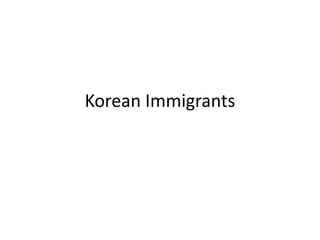
Rise of Korean Immigrants in the US
- 2. • The number of Korean immigrants in the United States grew 27-fold between 1970 and 2007, from 38,711 to 1.0 million, making them the seventh largest immigrant group in the United States after Mexican, Filipino, Indian, Chinese, Salvadoran, and Vietnamese foreign born. • Almost all Koreans in the United States are from South Korea, and over half of all Korean immigrants reside in just four states: California, New York, New Jersey, and Virginia
- 3. Size and Distribution • There were 1.0 million foreign born from Korea residing in the United States in 2007. • Korean immigrants made up 2.7 percent of all immigrants in 2007. • The majority of Korean immigrants are from South Korea. • Over half of all Korean immigrants resided in California, New York, New Jersey, and Virginia.
- 4. Demographic and Socioeconomic Overview • About one of every four Korean foreign born in the United States arrived in 2000 or later. • Over two-thirds of Korean immigrants in 2007 were adults of working age. • Korean immigrant women outnumbered men in 2007. • The majority of Korean immigrants were naturalized US citizens in 2007.
- 5. • Fifty-seven percent of Korean immigrants in 2007 were limited English proficient. • More than half of Korean foreign-born adults had a bachelor’s or higher degree. • Korean immigrant men and women were less likely to participate in the civilian labor force than foreign-born men and women overall. • About 40 percent of employed Korean-born men worked in management, business, finance, and sales.
- 6. Legal and Unauthorized Korean Immigrant Population • About 350,000 Koreans have gained lawful permanent residence in the United States since 1990. • Over half of Korean-born lawful permanent residents in 2007 were employment-based immigrants. • Korean-born lawful permanent residents made up 2.2 percent of all those eligible to naturalize as of 2006. • In 2007, 2 percent of all unauthorized immigrants in the United States were from Korea. • The number of unauthorized immigrants from Korea increased 31 percent between 2000 and 2007. • Size and Distribution
- 7. • There were 1.0 million foreign born from Korea residing in the United States in 2007. • The 1960 census counted 11,171 Korean immigrants, a number that increased 93-fold to 1,042,580 Korean immigrants in 2007. The Korean born were the seventh-largest foreign-born group in the United States in 2007 after immigrants from Mexico, the Philippines, India, China, El Salvador, and Vietnam. • Korean immigrants made up 2.7 percent of all immigrants in 2007. • In 1960, Korean immigrants composed 0.1 percent of all foreign born in the United States. That share increased to 2.1 percent in 1980 and to 2.9 percent in 1990. Korean immigrants’ share declined to 2.8 percent in 2000 a
- 8. Total and Korean Foreign-Born Populations, 1960 to 2007 • Year Foreign born • Korean born • Rank (a) Share of all foreign born Number • 1960 9,738,091 44 0.1% 11,171 • 1970 9,619,302 37 0.4% 38,711 • 1980 14,079,906 10 2.1% 289,885 • 1990 19,797,316 8 2.9% 568,397 • 2000 31,107,889 7 2.8% 864,125 • 2007 38,059,555 7 2.7% 1,042,580 • Notes: (a) Rank refers to the position of the Korean born compared to other immigrant groups in terms of size of the population residing in the United States in a given census year. • Source: Data for 2000 from the 2000 census; 2007 data from the American Community Survey 2007. Data for earlier decades from Campbell Gibson and Emily Lennon, "Historical Census Statistics on the Foreign-Born Population of the United States: 1850 to 1990" (US Census Bureau Working Paper No. 29, US Government Printing Office, Washington, DC, 1999). Available online.
- 9. The majority of Korean immigrants are from South Korea. • The American Community Survey, which provides population data between decennial census years, does not distinguish between immigrants born in South Korea from immigrants born in North Korea. • During the 2000 census, however, respondents were given the option of listing their place of birth as "Korea," "South Korea," or "North Korea." About 82 percent of Korean immigrants in 2000 listed their birthplace as "Korea," 18 percent listed "South Korea," and less than 1 percent listed "North Korea." • Since 2000, the United States has admitted 37 North Koreans as refugees (as of December 31, 2007). In 2004, the United States passed the North Korean Human Rights Act, which affirms that North Koreans are eligible for refugee status or asylum in the United States. • Although it does not impose any quota on the number of refugees or asylees admitted from North Korea, the United States remains cautious about resettling a large number of North Korean refugees fearing espionage or other sensitive activities. • Since 2000, the United States has also admitted about 257 North Koreans on temporary visas, the majority of which were tourists and business travelers; the number also includes about 23 students and exchange visitors.
